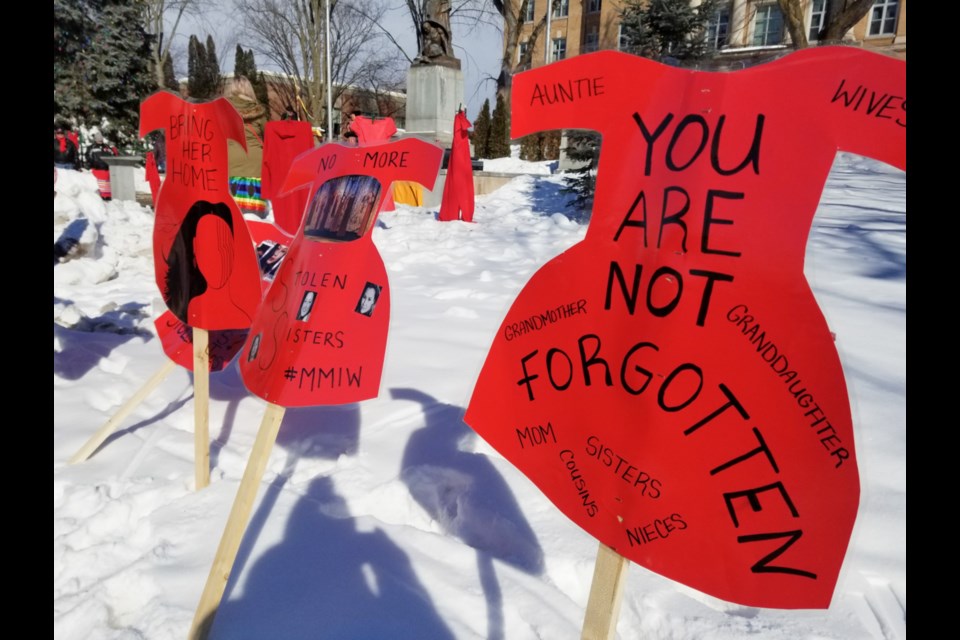At the June 3 launch of a National Action Plan, part of the investigation into the issue of Missing and Murdered Indigenous Women and Girls (MMIWG), Prime Minister Justin Trudeau held what he referred to as a sacred bundle, the Final Report of the Truth and Reconciliation Commission (TRC), wrapped in a traditional cradleboard.
He spoke of voices finally being heard, and to “accepting the findings of this report, including the description of genocide.”
As he spoke he made a promise to listen, to follow Indigenous-led actions, and thanked those present for the hard work they had put into the National Action Plan, just released.
However, not everyone is as pleased with the National Action Plan. In fact, many would dispute one word in particular, ‘action’.
“This is not a national action plan,” said Shelaugh Day of Femist Alliance for International Action, one of the speakers at the media advisory held in response to the launch of the National Action Plan. “An action plan has who, what, where, when,” said Day. “We were expecting concrete actions, resources, and responsibilities. This is a restatement of calls, but not much else.”
Though many present at the launch of the plan, including a visibly emotional Carolyn Bennett minister of Crown/Indigenous Affairs, as well as representatives from several Indigenous organizations that advised the creation of the plan offered words of praise to the prime minister, thanking him for listening and moving forward on many of the calls to action, there were others who spoke to feeling left out, once again.
Clément Chartier, president of the Métis National Council, said that while he was thankful Trudeau’s government had moved ahead with the TRC, and they have come to “a place of trust,” he is left wondering why the people of the Métis Nation are left out.
“Mr. Prime Minister, the truth is, Métis also attended residential schools, and we suffered worse because the other schools were federally funded. At least they got money for food.”
He also noted the lack of acknowledgement of the suffering of the Métis people during the Sixties Scoop. “We hope we can be included.”
Also left out are hundreds of organisations that work directly with Indigenous women and girls, says Dr. Dawn Lavell-Harvard, president of the Ontario Native Women’s Association (ONWA).
In fact, all of the women’s organizations represented that reacted to the National Action Plan were not included in the list of groups developing it, including ONWA, the Quebec Native Women’s Association, the Feminist Alliance for International Action and the Union of B.C. Indian Chiefs.
All had not only requested a seat at the table during the process, but say they fought for it and were declined. They could not even comment on those groups that were included, as they had been hand-selected by the federal government in a closed process.
Sharon McIvor of the Feminist Alliance for International Action said that any plan that does not include efforts to bring women back to the First Nations they were a part of, cannot help.
“The ongoing discrimination of the Indian Act and it’s tools of assimilation is the key reason women and girls are in this position today.”
Though there are many issues with the government-enacted legislation, one of the great harms against Indigenous women is that if they marry a non-Indigenous partner, they lose their status.
Currently, McIvor said, “a passport will take three or four days. But even if you're already registered, a status card will take three or four years.” McIvor says that is causing women to lose out on the resources and healthcare available to them, simply because of the Indian act. She said that any National Action Plan that doesn’t “just hand these women their status back” isn’t going to help.
Lavell-Harvard of ONWA said another key point missing is a focus on prevention.
“Addressing the needs of the families and survivors through a National Action Plan that does not have a focus on prevention will never break that cycle.”
Lavell-Harvard said there is still a need to listen to the survivors who were not chosen to add to the plan, and to restore a balance based on Indigenous women's leadership.
“We need to heal,” she said, holding back tears. “And it’s going to take time.”
Cora McGuire-Cyrette, executive director of ONWA, stated her thoughts clearly in a release from the organization.
“The National Action Plan speaks of systemic racism and colonialism, but forgets to address immediate safety needs, sexism, patriarchy and their intersectional natures. Indigenous women go missing and are murdered because they are Indigenous and because they are women. We expected a National Action Plan to provide concrete solutions to this violence.”
When asked how she would describe the National Action Plan, Judy Wilson, secretary-treasurer of the Union of BC Indian Chiefs put it quite plainly.
“This is delayed and denied justice,” she said. “No accountability of government, our rights are not recognized or respected, and it is all going to fall back on us (the grassroots organizations.)”
She also had a question. “What is Canada afraid of?”
